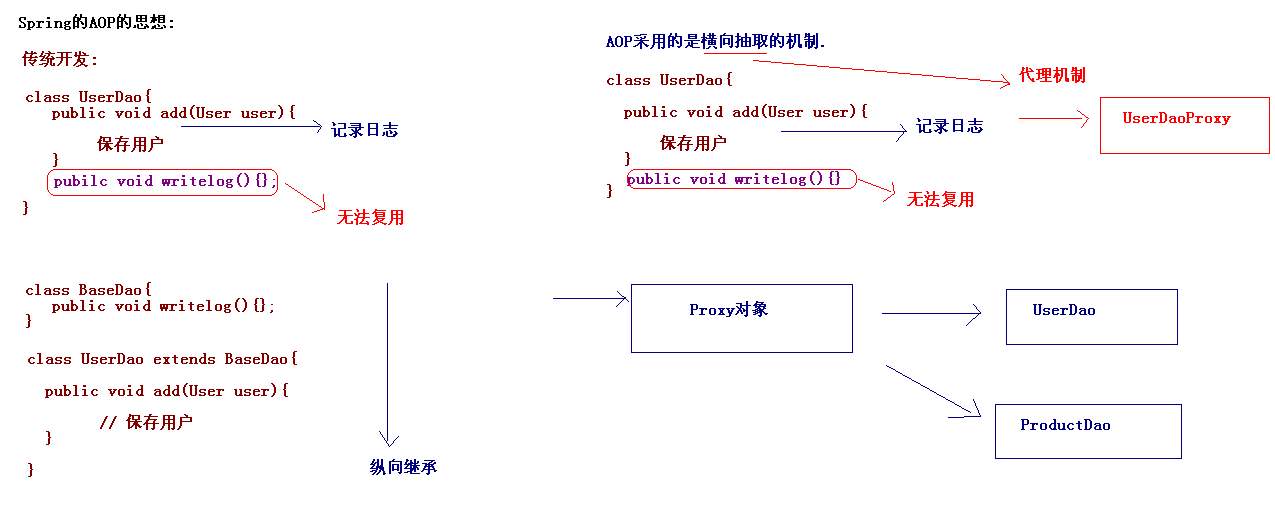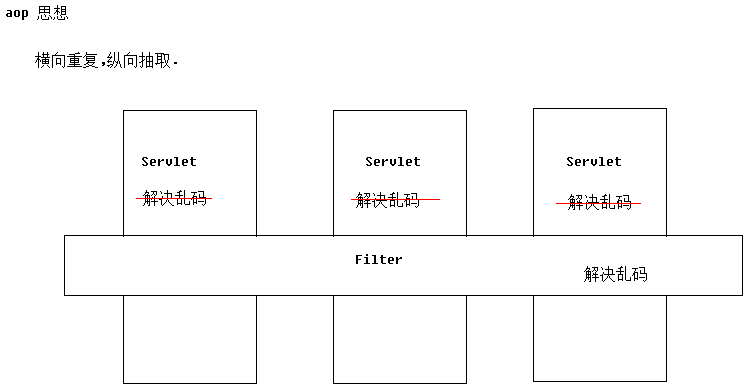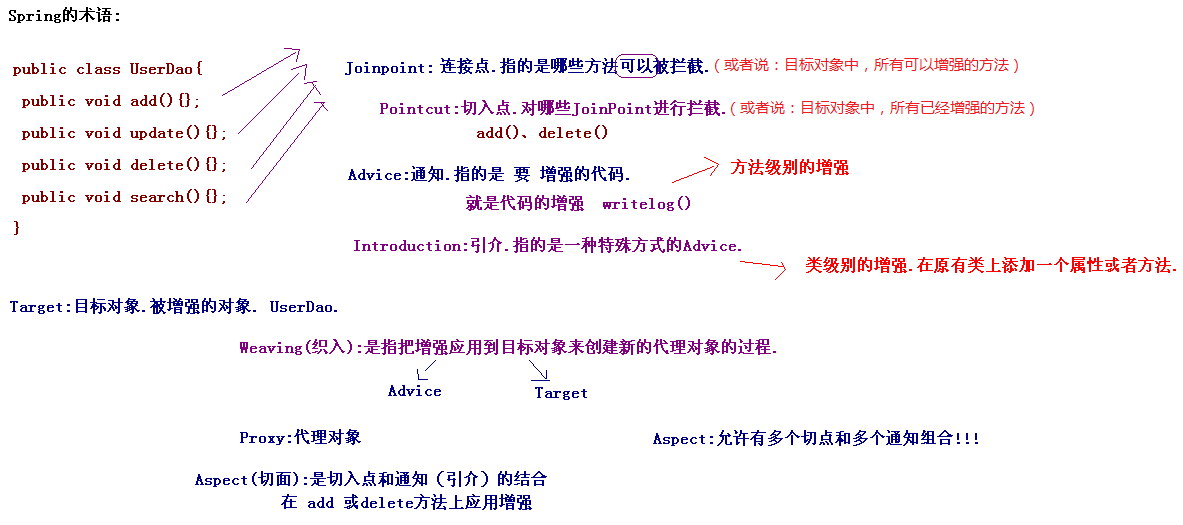
参考资料:https://lfvepclr.gitbooks.io/spring-framework-5-doc-cn/content/
1. AOP 原理
AOP Aspect Oriented Programing,面向切面编程。
AOP 采取横向抽取机制,取代了传统纵向继承体系重复性代码(性能监视、事务管理、安全检查、缓存)
Spring AOP 使用纯 Java 实现,不需要专门的编译过程和类加载器,在运行期通过代理方式向目标类织入增强代码。
AOP底层原理:就是代理机制
动态代理:
特点:字节码随用随创建,随用随加载
作用:不修改源码的基础上对方法增强
分类:
- 基于
接口的动态代理 - JDK 动态代理
- 基于
继承的动态代理 - CGLib 动态代理
1.1 JDK 动态代理
1
2
3
4
| public interface UserDao {
public void add();
public void update();
}
|
1
2
3
4
5
6
7
8
| public class UserDaoImpl implements UserDao {
public void add() {
System.out.println("add...");
}
public void update() {
System.out.println("update...");
}
}
|
- JDK 动态代理机制(实现 InvocationHandler 接口,重写 invoke() 方法)
1
2
3
4
5
6
7
8
9
10
11
12
13
14
15
16
17
18
19
20
21
22
23
24
25
26
27
28
| public class JDKProxy implements InvocationHandler{
private UserDao userDao;
public JDKProxy(UserDao userDao) {
this.userDao = userDao;
}
public UserDao createProxy() {
UserDao proxy = (UserDao) Proxy.newProxyInstance(
userDao.getClass().getClassLoader(),
userDao.getClass().getInterfaces(),
this);
return proxy;
}
@Override
public Object invoke(Object proxy, Method method, Object[] args)
throws Throwable {
if("update".equals(method.getName())){
System.out.println("日志记录...");
Object result = method.invoke(userDao, args);
return result;
}
return method.invoke(userDao, args);
}
}
|
- JDK 动态代理机制(匿名内部类直接调用返回代理对象,与实现 InvocationHandler 接口等价)
1
2
3
4
5
6
7
8
9
10
11
12
13
14
15
16
17
18
19
20
21
22
23
| public class TestProxy {
public static void main(String[] args) {
UserDao userDao = new UserDaoImpl();
UserDao p = (UserDao) Proxy.newProxyInstance(
userDao.getClass().getClassLoader(),
userDao.getClass().getInterfaces(),
(proxy, method, argss) -> {
String methodName = method.getName();
Object result;
if ("add".equals(methodName)) {
System.out.println("日志记录...");
result = method.invoke(userDao, argss);
} else {
result = method.invoke(userDao, argss);
}
return result;
});
p.add();
p.update();
}
|
1
2
3
4
5
6
7
8
9
10
11
12
13
14
15
16
17
18
| import org.junit.Test;
public class SpringDemo1 {
@Test
public void test1(){
UserDao userDao = new UserDaoImpl();
userDao.add();
userDao.update();
}
@Test
public void test2(){
UserDao userDao = new UserDaoImpl();
UserDao proxy = new JDKProxy(userDao).createProxy();
proxy.add();
proxy.update();
}
}
|
test2 结果中打印了增强方法的信息:日志记录… add… update…
1.2 CGLib 动态代理
1
2
3
4
5
6
7
8
| public class ProductDaoImpl {
public void add(){
System.out.println("add...");
}
public void update(){
System.out.println("update...");
}
}
|
- CGLib 动态代理机制(实现 MethodInterceptor 接口,重写 intercept() 方法)
1
2
3
4
5
6
7
8
9
10
11
12
13
14
15
16
17
18
19
20
21
22
23
24
25
26
27
28
29
30
31
32
|
public class CGLibProxy implements MethodInterceptor{
private ProductDaoImpl productDao;
public CGLibProxy(ProductDaoImpl productDao) {
this.productDao = productDao;
}
public ProductDaoImpl createProxy(){
Enhancer enhancer = new Enhancer();
enhancer.setSuperclass(productDao.getClass());
enhancer.setCallback(this);
return (ProductDaoImpl) enhancer.create();
}
@Override
public Object intercept(Object proxy, Method method, Object[] args, MethodProxy methodProxy) throws Throwable {
if("add".equals(method.getName())){
System.out.println("日志记录...");
Object obj = methodProxy.invokeSuper(proxy, args);
return obj;
}
return methodProxy.invokeSuper(proxy, args);
}
}
|
1
2
3
4
5
6
7
8
9
10
11
12
13
14
15
16
17
| import org.junit.Test;
public class SpringDemo2 {
@Test
public void test1(){
ProductDaoImpl productDao = new ProductDaoImpl();
productDao.add();
productDao.update();
}
@Test
public void test2(){
ProductDaoImpl productDao = new ProductDaoImpl();
ProductDaoImpl proxy = new CGLibProxy(productDao).createProxy();
proxy.add();
proxy.update();
}
}
|
test2 结果中打印了增强方法的信息:日志记录… add… update…
1.3 Spring AOP 代理方式
JDK 动态代理:被代理对象必须要实现接口,才能产生代理对象,如果没有接口将不能使用动态代理技术。CGLib 代理机制:第三方代理技术,CGLib 代理,可以对任何类生成代理。代理的原理是对目标对象进行继承代理。 如果目标对象被 final 修饰,那么该类无法被 CGLib 代理。
【结论】
Spring 框架中:
- 如果类实现了接口,就使用 JDK 的动态代理生成代理对象;
- 如果这个类没有实现任何接口,使用 CGLib 生成代理对象。


2. AOP 术语
- Joinpoint(
连接点) : 所谓连接点是指那些被拦截到的点。在 spring 中,这些点指的是方法,因为 spring 只支持方法类型的连接点。
- Pointcut(
切入点) : 所谓切入点是指我们要对哪些 Joinpoint 进行拦截的定义。
- Advice(
通知/增强) : 所谓通知是指拦截到 Joinpoint 之后所要做的事情就是通知,通知分为前置通知、后置通知、异常通知、最终通知、环绕通知(切面要完成的功能)。
- Introduction(引介) : 引介是一种特殊的通知在不修改类代码的前提下, Introduction 可以在运行期为类动态地添加一些方法或 Field。——类级别的增强。
- Target(
目标对象) : 代理的目标对象
- Weaving(
织入) : 是指把增强应用到目标对象来创建新的代理对象的过程,spring 采用动态代理织入,而AspectJ 采用编译期织入和类装载期织入。
- Proxy(
代理) : 一个类被 AOP 织入增强后,就产生一个结果代理类
- Aspect(
切面) : 是切入点和通知(引介)的结合

3. AOP 实现
- 依赖配置
在 pom.xml 添加 aop 依赖:aspectjweaver
1
2
3
4
5
| <dependency>
<groupId>org.aspectj</groupId>
<artifactId>aspectjweaver</artifactId>
<version>1.8.13</version>
</dependency>
|
- 创建通知类
- 前置通知(before):目标方法运行
之前调用
- 最终通知(after):在目标方法运行
之后调用 (无论是否出现异常)
- 后置通知(after-returning):在目标方法运行
之后调用 (未出现异常就会调用)
- 异常拦截通知(after-throwing):在目标方法运行
之后调用(如果出现异常就调用)
- 环绕通知(around):在目标方法
之前和之后都调用 (ProceedingJoinPoint对象 –>> 调用proceed方法)
1
2
3
4
5
6
7
8
9
10
11
12
13
14
15
16
17
18
19
20
21
22
23
24
| public class MyAdvice {
public void before() {
System.out.println("前置通知(执行目标方法之前执行)");
}
public void after() {
System.out.println("后置通知 目标方法之后执行(无论是否发生异常都会执行)");
}
public void after_returning() {
System.out.println("后置通知 目标方法之后执行(未发生异常才执行)");
}
public void after_throwing() {
System.out.println("异常通知(发生异常才执行)");
}
public Object around(ProceedingJoinPoint joinPoint) throws Throwable {
System.out.println("环绕通知(执行目标方法之前)");
Object proceed = joinPoint.proceed();
System.out.println("环绕通知(执行目标方法之后)");
return proceed;
}
}
|
3.1 XML 配置 AOP
创建 applicationContext.xml,添加 aop 约束
1
2
3
4
5
6
7
8
9
10
11
12
13
14
15
16
17
18
19
20
21
22
23
| <aop:config>
<aop:pointcut id="pc" expression="execution(* com.demo.service.*ServiceImpl.*(..))" />
<aop:aspect ref="myAdvice" >
<aop:before method="before" pointcut-ref="pc" />
<aop:after method="after" pointcut-ref="pc"/>
<aop:after-returning method="after_returning" pointcut-ref="pc" />
<aop:after-throwing method="after_throwing" pointcut-ref="pc"/>
<aop:around method="around" pointcut-ref="pc" />
</aop:aspect>
</aop:config>
|
3.2 注解 配置 AOP-推荐
Spring中的注解配置AOP:
1
2
3
4
5
6
7
8
9
10
11
12
13
14
15
16
17
18
19
20
21
22
23
24
25
26
27
28
29
30
31
32
33
34
35
36
37
38
39
40
|
@Aspect
public class MyAdvice {
@Pointcut("execution(* com.demo.service.*ServiceImpl.*(..))")
public void pc(){}
@Before("MyAdvice.pc()")
public void before() {
System.out.println("前置通知(执行目标方法之前执行)");
}
@After("execution(* com.demo.service.*ServiceImpl.*(..))")
public void after() {
System.out.println("后置通知 目标方法之后执行(无论是否发生异常都会执行)");
}
@AfterReturning("execution(* com.demo.service.*ServiceImpl.*(..))")
public void after_returning() {
System.out.println("后置通知 目标方法之后执行(未发生异常才执行)");
}
@AfterThrowing("execution(* com.demo.service.*ServiceImpl.*(..))")
public void after_throwing() {
System.out.println("异常通知(发生异常才执行)");
}
@Around("execution(* com.demo.service.*ServiceImpl.*(..))")
public Object around(ProceedingJoinPoint joinPoint) throws Throwable {
System.out.println("环绕通知(执行目标方法之前)");
Object proceed = joinPoint.proceed();
System.out.println("环绕通知(执行目标方法之后)");
return proceed;
}
}
|
1
2
3
4
5
6
7
8
9
10
11
12
13
14
15
16
17
18
19
20
21
22
|
<?xml version="1.0" encoding="UTF-8"?>
<beans xmlns:xsi="http://www.w3.org/2001/XMLSchema-instance"
xmlns="http://www.springframework.org/schema/beans"
xmlns:context="http://www.springframework.org/schema/context"
xmlns:aop="http://www.springframework.org/schema/aop"
xsi:schemaLocation="http://www.springframework.org/schema/beans
http://www.springframework.org/schema/beans/spring-beans-4.2.xsd
http://www.springframework.org/schema/context
http://www.springframework.org/schema/context/spring-context-4.2.xsd
http://www.springframework.org/schema/aop
http://www.springframework.org/schema/aop/spring-aop-4.2.xsd ">
<bean name="userService" class="com.demo.service.UserServiceImpl" />
<bean name="myAdvice" class="com.demo.annotation_aop.MyAdvice" />
<aop:aspectj-autoproxy />
</beans>
|
3.3 切点正则和指示器
正则:
execution(* com.springboot.chapter4.aspect.service.impl.UserServiceImpl.printUser(..))
指示器:
| 项目类型 |
描述 |
| arg() |
限定连接点方法参数 |
| @args() |
通过连接点方法参数上的注解进行限定 |
| execution() |
用于匹配是连接点的执行方法 |
| this() |
限制连接点匹配AOP代理Bean引用为指定的类型 |
| target |
目标对象(即被代理对象) |
| @target() |
限制目标对象的配置了指定的注解 |
| within |
限制连接点匹配执行的类型 |
| @windin() |
限定连接点带有匹配注解类型 |
| @annotation |
限定带有指定注解的连接点(常与自定义注解合用,极其好用) |



